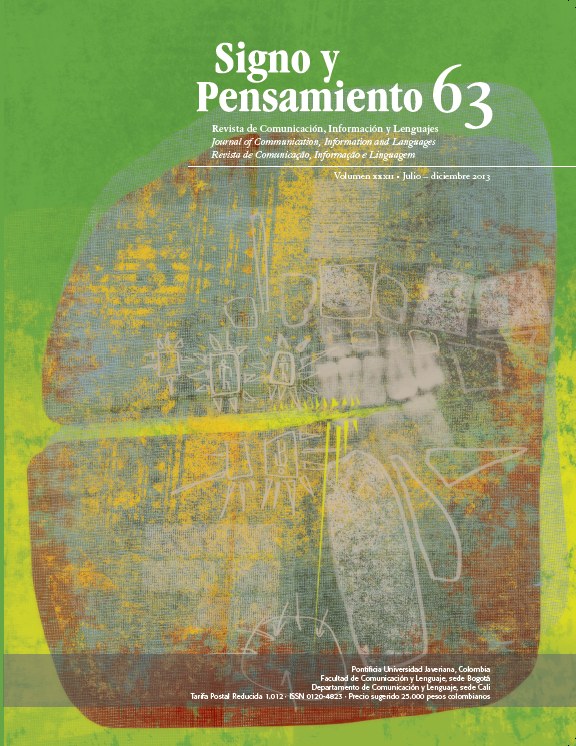Abstract
For Martin-Barbero and Rey (1999), the study of communication focuses, from the beginning of the current decade, in the organizational communication, and is marked by a strategic approach to achieve its management status and its power. The purpose of this study is to determine whether the managerial function of communication is being exercised in the largest companies of higher sales in Colombia. Personal and telephone surveys of semi-structured questions were applied to the communication directors of the 21 companies of higher sales in Colombia, in accordance with the Dinero magazine’s list (2010). We found that although there is a generally positive positioning of the managers responsible for strategic communication in Colombia’s largest companies, its influence is limited in certain areas, responsibilities or stakeholders, so they do not meet fully their strategic management.
D’Aprix, R. (2010). Spite social media tools, face-toface interaction in organizations has remained the same: IABC survey. Recuperado de http:// search.proquest.com/docview/232912553/13 12FD47F692D4F50C7/1?accountid=48417.
Costa, J. (2001). El director de comunicación. Dirección de comunicación empresarial e institucional. Barcelona: Gestión 2000.
Las 100 más grandes. (28 de mayo de 2010). Dinero, p. 350, 98.
DirCom, Asociación de Directivos de Comunicación (5 de mayo de 2010). El estado de la comunicación en España. Recuperado de http://www.dircom.org/images/stories/ news/Noticias/ActualidadDircom/presentacionestadodelacomunicacione%20 espaa2010.pdf
Echenique, R. (2009). Crecimiento y desarrollo de la industria de la comunicación estratégica en Chile. Chasqui, 108. Recuperado de http://web.ebscohost.com/ehost/pdfviewer/pdfviewer?hid=112&sid=ed6ca73d-9197-4de6- 991d-42b8e400e5a5%40sessionmgr110&vid=6
Forman, J. (2004). Multiple roles in responding to strategic communications. Business Communication Quarterly, 67, 281-293. Recuperado de http://bcq.sagepub.com/content/67/3/281.full.pdf+html
Grunig, J. (12 de mayo de 2001). The role of PR in management and its contribution to organizational and societal effectiveness [speech], Taipei, Taiwan. Recuperado de http://www. instituteforpr.org/wp-content/uploads/2001_ PRManagement.pdf
Hale, D. (2010, Diciembre). From the desk of Che. PRSA Public Relations Society of America. Recuperado de http://www.prsa.org/ network/communities/che/intelligence/ newsletter/ chefromthedesk1210?utm_ campaign=PRSASearch&utm_ source=PRSAWebsite&utm_ medium=SSearch&utm_ term=management%20function
Martín-Barbero, J., & Rey, G. (1999). La formación del campo de estudios de comunicación en Colombia. Revista de Estudios Sociales, 4, 54-70. Recuperado de http://web.ebscohost.com/ehost/pfdviewer/pdfviewer?vid =9&hid=108&sid=dd385a68-ba58-4410- be3656214545945e%40sessionmgr III.
Monitor de la Comunicación Europea. (2012). Recuperado de http://www.zerfass.de/ecm/ ECM2012-Results-ChartVersion.pdf
Ortiz, K. (2011, marzo-junio). Comunicación corporativa: nuevos desafíos para nuevas realidades, DIRCOM, 90, 6-8.
Pérez, R. (2008). Estrategias de comunicación. Barcelona: Book Print Digital.
Preciado, A., & Guzmán, H. (2011, junio-agosto). ¿Cómo utilizan la comunicación estratégica las organizaciones colombianas?DIRCOM, 91, 31-35.
Public Relations Society of America (prsa) (2010). Global research study finds that public relations is consistently taught as a strategic management function. Recuperado de http://media.prsa.org/ article_display.cfm?article_id=1653&utm_ campaign=PRSASearch&utm_ source=PRSAWebsite&utm_ medium=SSearch&utm_ term=management%20function
Scheinsohn, D. (2009). Comunicación estratégica. Revista de Antiguos Alumnos del ieem, 12, 94-95. Recuperado de http://web.ebscohost.com/ ehost/pdfviewer/pdfviewer?vid=18&hid= 108 &sid=dd385a68-ba58-4410 -be36 - 56214545945e%40sessionmgr111.
Trivitt, K. (22 de diciembre de 2010). Public relations trends for 2011. PRSAY What do you have to say? Recuperado de htpp://prsay.prsa.org/ index.php/2010/12/22/2011-pr-trends/
Villegas, D. (2008). ¿Se está gestando una nueva teoría estratégica desde Iberoamérica? Revisión y comparación del campo anglosajón e iberoamericano. Revista de Estudios de Comunicación, 14, 225-249. Recuperado de http:// web.ebscohost.com/ehost/pdfviewer/pdfvie wer?vid=12&hid=108&sid=dd385a68-ba58- 4410-be36-56214545945e%40sessionmgr111.
This journal is registered under a Creative Commons Attribution 4.0 International Public License. Thus, this work may be reproduced, distributed, and publicly shared in digital format, as long as the names of the authors and Pontificia Universidad Javeriana are acknowledged. Others are allowed to quote, adapt, transform, auto-archive, republish, and create based on this material, for any purpose (even commercial ones), provided the authorship is duly acknowledged, a link to the original work is provided, and it is specified if changes have been made. Pontificia Universidad Javeriana does not hold the rights of published works and the authors are solely responsible for the contents of their works; they keep the moral, intellectual, privacy, and publicity rights.
Approving the intervention of the work (review, copy-editing, translation, layout) and the following outreach, are granted through an use license and not through an assignment of rights. This means the journal and Pontificia Universidad Javeriana cannot be held responsible for any ethical malpractice by the authors. As a consequence of the protection granted by the use license, the journal is not required to publish recantations or modify information already published, unless the errata stems from the editorial management process. Publishing contents in this journal does not generate royalties for contributors.


